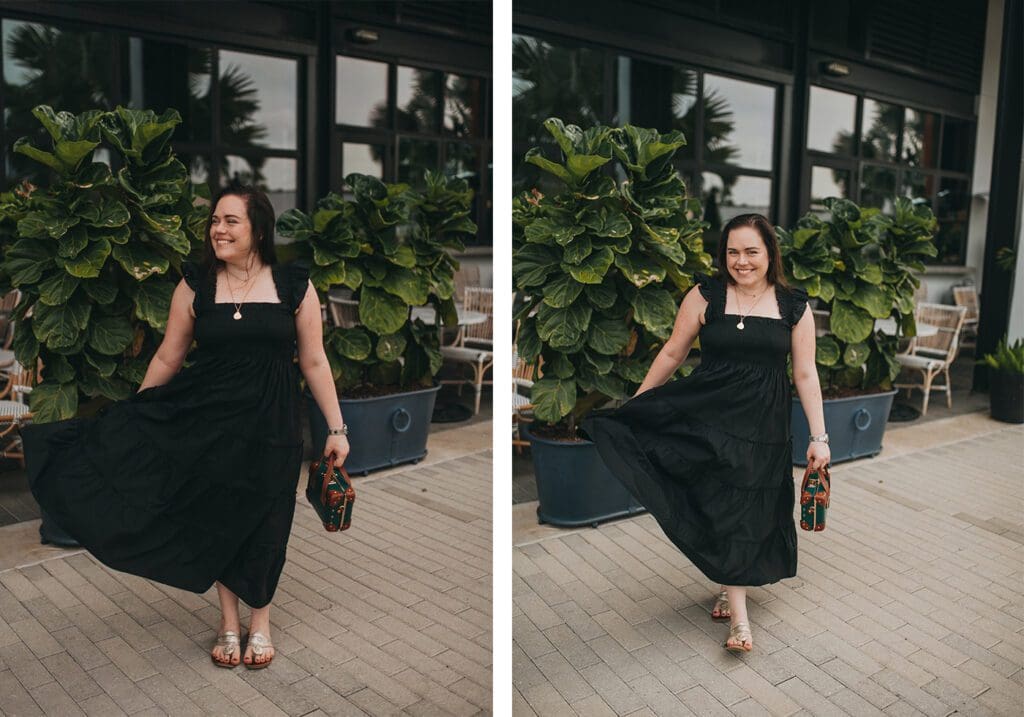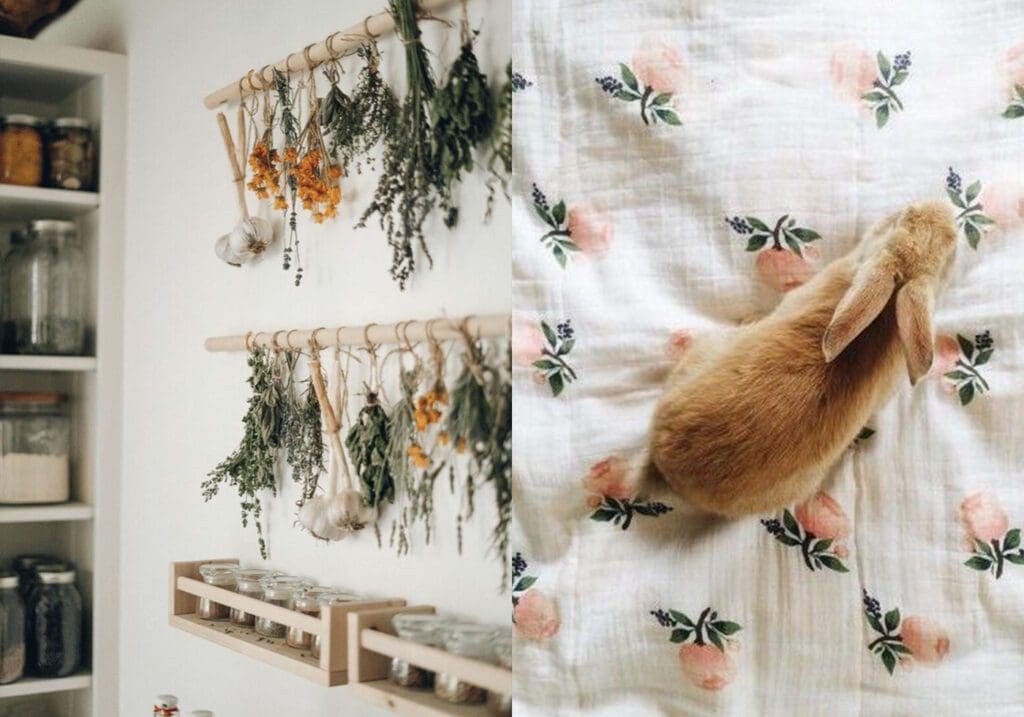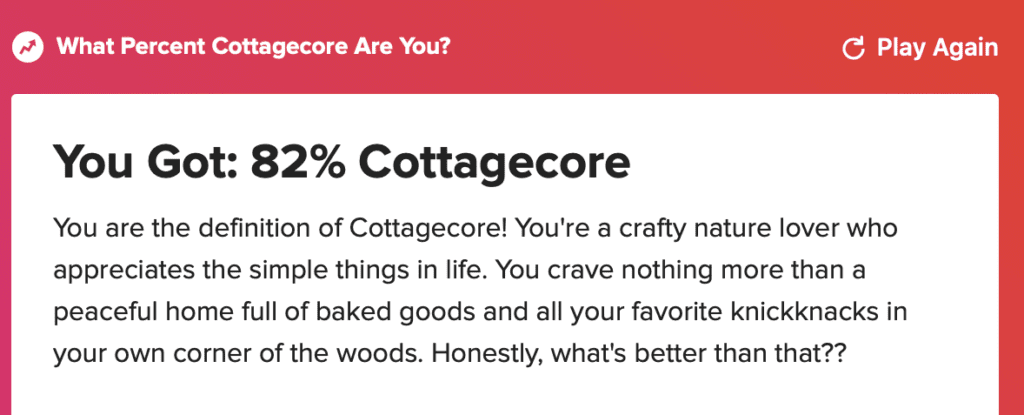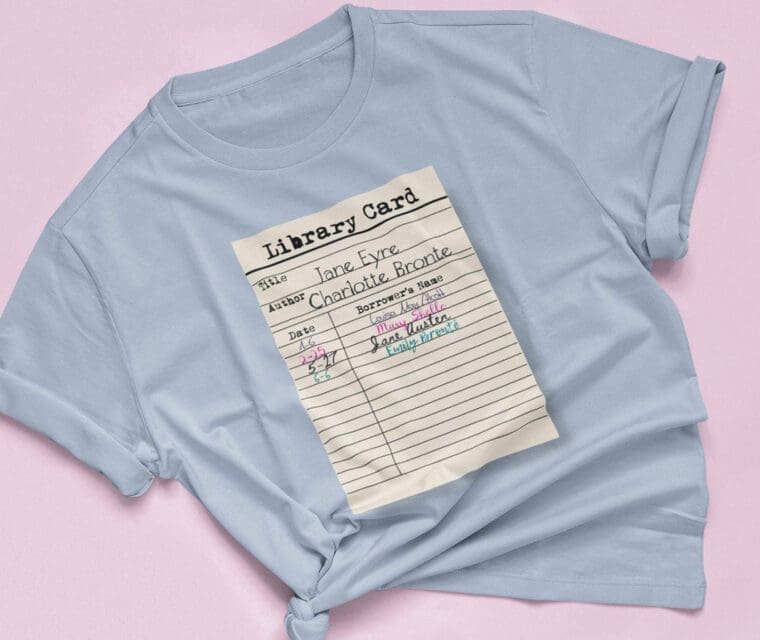Cottagecore Aesthetic on TikTok and Instagram
In my recent attempts to understand TikTok, I came across a genre of post that struck me as rather lovely. These were simple, pastoral photos and videos set to soft music or nature sounds. Turns out, there’s a name for this look: the cottagecore aesthetic.
Sometimes called “farmcore” or “countrycore,” the visual trend evokes a romanticized dream version of western pastoral or agricultural life. Cottagecore relies on the handmade or analogue — ironic as the trend has been popularized online through social media (particularly TikTok) and monetized in fast fashion stores.
Table of Contents

I call this my dark cottagecore look, featuring: the Hill House Nap Dress in black, Jack Rogers in platinum, and SteamLine Mini purse
Shop My Curated Cottagecore Finds Here!
Influences on the Cottagecore Aesthetic
The cottagecore find coincided with a personal renewed interest in “slow living,” something I’ve been following along with for the aesthetic and pretty pictures, but have been delving more deeply into since the pandemic hit.
As such, this made me realize that the cottagecore aesthetic seems to embrace a few trends that have been developing lately. This includes the idea of placing an emphasis on shopping small rather than for mass produced goods, repurposing items where possible instead of sending them off as trash, and general plant mom life (or the idea of having a plant paradise in your home; see, e.g., The Heavy in Winter Park, Florida).

I now realize that my own photography style — particularly when it comes to photographing my Critter Crafting Crochet products like these silver coasters — is inspired by the cottagecore aesthetic
Cottagecore Styles & Inspiration
From long dresses to pretty pastels, the cottagecore aesthetic has made its way into many of the most popular stores over the past year. One you become aware of it, I’m sure you’ll see it’s influence all over the place — from casual t-shirts to cocktail dresses and everything in between. Further, if you’re finding comfort in the earthy tones and grounded designs of this aesthetic, that’s a sign to add some of these elements to your home. Many cottagecore style pieces feature flowers and earthy tones. From accents and planters to wall art and kitchen wares, you’ll find plenty of great cottagecore home design pieces here.

Examples of Cottagecore inspired purses and accessories for her from Fable England.
Clockwise from top left:
Various Jewelry Boxes
Embroidered Mouse Crossbody Bag
Embroidered Deer Crossbody Bag
Into the Woods Tote Bag Mini
What is Cottagecore?
The cottagecore aesthetic is a look and feel inspired by an (overly) romanticized vision of rural life. Cottagecore is a style — arguably even a photo editing style — that is pervasive online if you know where to look. It is based on the idea of living a simpler life from a simpler time. It features a harmonious relationship with nature. There are elements of sustainability and DIY creating. Cottagecore seeks to support small businesses — bonus points for pieces that are sustainably made from natural fibers.

Examples of cottagecore styled photos. Photo sources: left – right
The key motifs of the aesthetic revolve around wildflowers, cottages, baked goods, and farming life. Think Sofia Coppola’s The Virgin Suicides with hints of Outlander‘s scenery and herbs. Then, add in fairies, pressed flowers, vintage tea sets, and cross stitch.

Examples of cottagecore styled photos. Photo sources (clockwise from left): one – two – three
A good deal of the style rejects capitalism and mass-production in favor of the handmade and agrarian. There are a lot of mushrooms in cottagecore, plus an emphasis on foraging and living off the land.
So, as someone who crochets and regularly wishes she could live in a remote cabin in Scotland (but knows, realistically, that I need a Target near by…), it’s hardly a surprise that I scored an 82% on Buzzfeed’s “Are you Cottagecore” quiz.

Learning About the Cottagecore Trend
I did some research into the trend. Notably, I found it was oddly alluring considering I’m regularly bemoaning the pandemic-induced isolation. I was not alone in this, as the trend has increased in popularity since the start of the pandemic. Instead, Cottagecore’s population is because of the isolation and anxiety people are feeling, since the lifestyle is inspired by the idea of simpler, more tranquil times.
Insider shared an article about the phenomenon, and touched on the contradiction I was feeling. They interviewed Amanda Brennan, Tumblr’s Head of Content Insights and Social, who shared some great insights:
While it feels like trading one isolation for another on the surface, Brennan attributes some of cottagecore’s appeal during social distancing to the fantastical agency it provides. “It’s an isolation that is chosen rather than subjected to you If you’re on a secluded island or living off in the woods, you’re choosing to do that,” Brennan explained. “Realizing it gives you some sort of control over this time where we have to self-isolate for us as a culture… People are just trying to find comfort, and flipping the script a bit. I can just be in this beautiful place in my head, a place where it is quiet and isolated, but it’s something I chose.”
Amanda Brennan speaking to Palmer Haasch of Insider
Amelia Ansink, Fashion Snoops‘ accessories editor, noted in an article from Today, “during the worldwide pandemic and long periods of stay-at-home orders,” the aesthetic “unintentionally [came to represent] the ideal quarantine life, where isolation in nature is strived for and everything we need can be produced at home by our own hands.”
Criticisms of the Cottagecore Aesthetic
Cottagecore does not specifically support any particular political ideology. However, the cottagecore aesthetic has been politicized in a few key ways. At best, cottagecore is unrealistic and tone-deaf. At worst, it is pure colonialism.
The Politicization of Cottagecore
The progressive side of cottagecore rejects traditional, heteronormative gender roles. However, others use the imagery to promote the patriarchy, reject feminism, and assert a western colonial and Eurocentric worldview.
In my research, I found that this pro-patriarchy view has been labeled “Tradlife” or “traditional” lifestyles. It seems that this pro-patriarchy faction has attempted to take advantage of some of the more “traditional” aspects of cottagecore, like interests in cooking and gardening.
But, where Tradlife wants a return to the 1950s era patriarchy, cottagecore seems to seek a more evolved future, outside the realm of harsh capitalism.
The Colonialist Critique of Cottagecore
This second criticism of cottagecore is something that has really stuck with me.
At its core, cottagecore is Eurocentric, espousing a mythical pastoral style reminiscent of the early parts of Sound of Music (you know, before the Nazis). Much of it is based on a romanticization of the past that did not truly exist. Or, if it did manage to exist for a few special people, it certainly did not for the majority.
The “simpler times” notion is alluring. However, it is ultimately a fallacy built on a Western and Eurocentric white colonialism narrative. It overlooks many harsh realities of stolen lands and peoples.
Closing Thoughts on the Cottagecore Aesthetic
Farming is hard (seriously, check out This Farming Life). Colonialism’s legacy is very much still with us. Capitalism is the root of many of our problems. I know I wouldn’t want to live in a cottage without air conditioning. These things can all be true simultaneously.
At the same time, though, I think there is still room for a romanticized ideal of life, realistic or not. The key, I think, is to not overlook the faults, and to ensure your worldview is expansive and inclusive.
I still find images by creatives like A Clothes Horse, Dear Tally, and Here At the Cottage to be alluring. It’s a nice bit of escapism and inspiration. Really, it’s not unlike why so many people are drawn to shows like Outlander — romantic imagery of another world. A lot of it is about pretty pictures — comfy homes, inspiring landscapes — so take it for what it is: escapism.
If, on the other hand, you want something grounded more in reality, I recommend exploring the slow living community online. For example, check out Jessica Rose Williams’ slow living blog. There seems to be an overlap of pretty photos, baking, and tea, with a bit more overt social awareness.

I recently picked up some adorable spools from Etsy to use in my photos. Upon researching the cottagecore aesthetic, I realize they really fit that theme.
Cottagecore Accounts to Explore
- @aclotheshorse on Instagram and TikTok – check out her Outlander inspired video
- @hereatthecottage on Instagram and TikTok
- @magicinsalem on Instagram
- @jess.her on Instagram and TikTtok
- @thefoxandtheivy on Instagram
- Tamed Wild — a bit more of a witchy vibe, but the aesthetics tend to overlap; I love their seasonal subscription boxes!
Further Reading on Cottagecore
- Cottagecore, Aesthetic Wiki
- The Cottagecore Aesthetic: What Is It and How to Get It, For You Aesthetics
- Cottagecore is the pastoral fantasy aesthetic taking over TikTok, I-D Vice
- ‘Cottagecore’ fashion aesthetic brings back a simpler time, Today
- People online are flocking to ‘cottagecore,’ an online aesthetic that idealizes agricultural life, to calm their hyper-stimulated nerves, Insider
Thanks for reading! If you found this post useful and want to support my work with Cats & Coffee, I’d be incredibly grateful!
You can buy me a coffee here:
*This post was originally published in 2020. It was most recently updated on February 12, 2024.



Your photos are very lovely! I’ve found myself deeply in love with the cottagecore aesthetic too. So reading this was heaven 🙂
Thank you so much! I’m so glad you enjoyed it 🙂